- Submissions

Full Text
Trends in Textile Engineering & Fashion Technology
Customer Satisfaction and Repurchase Intention in Online Fashion Retailing: A Cluster Analysis
M Krishnakumar1*, Mukthy S2 and Chithira P3
1Professor, Department of Fashion Management Studies, National Institute of Fashion Technology, India
2Assistant Professor, Department of Fashion Management Studies, National Institute of Fashion Technology, India
3MFM PG Scholar (2021 - 23), Department of Fashion Management Studies, National Institute of Fashion Technology, India
*Corresponding author:M Krishnakumar, Professor, Department of Fashion Management Studies, National Institute of Fashion Technology, Kannur - 670562, Kerala, India
Submission: March 20, 2024; Published: May 01, 2024

ISSN 2578-0271 Volume9 Issue5
Abstract
Customer satisfaction is essential in online shopping because it directly influences the success of the business. Since the online fashion industry is highly competitive nowadays, it is important for companies to establish a loyal customer base and differentiate themselves from their competitors. Satisfied customers are more likely to repeat purchases, give positive feedback to friends and relatives and be loyal to the brand. By implementing various strategies, companies can create a positive shopping experience and increase the likelihood of repeat purchases in online shopping. The purpose of the study is to examine customer satisfaction, understanding its impact on repurchase intention and clustering the customers based on their satisfaction and repurchase intention for an online fashion brand. Data were collected by non-probability, convenient sampling method using a structured questionnaire from the 200 respondents. The data analysis shows that there is significant difference among the demographic and cluster groups towards the repurchase intention. Based on the finding suggestion and managerial implications are provided to improve overall customer experience in ecommerce website.
Keywords:Customer satisfaction; Online; Fashion retailing; Repurchase intention; Cluster analysis
Introduction
Online shopping in India has become increasingly popular over the years due to the convenience, variety of products, and attractive discounts offered by e-commerce websites. Customer satisfaction is a crucial aspect of online shopping as it plays a significant role in the success of e-commerce businesses. It is important to understand the relationship between various factors of online shopping and consumer purchase behaviour in an online shopping context [1]. Several elements can influence customer satisfaction such as online shopping, including website design, ease of use, product quality, pricing, delivery, customer service etc. [2,3]. Customers expect a seamless and hassle-free experience when shopping online, and any difficulty in the process can result in lower satisfaction levels. Customers are likely to be satisfied if they feel that they are getting value for their money and if the prices are reasonable and competitive [4]. There are several factors that can influence repurchase intention, such as the quality of the product, customer service, pricing, brand reputation, and overall customer experience. If customers have had a positive experience with the product or service and perceive the brand to be reliable and trustworthy, they are more likely to repurchase [5,6]. The identification of the key elements of customer satisfaction that are relevant includes factors such as website/ app usability, information availability, price, delivery and quality. The aim of the study is to assess how customer satisfaction influences the intention to repurchase. The customer can be clustered to identify the customer satisfactory elements and repurchase intention of the respondents in different groups. The research also studies if the repurchase intention differs between customers with respect to demographic characteristics.
Literature Review
Online purchase
Various factors influence customer satisfaction with online buying. Vasić, et al. [3] investigated and analyse the relationship between customer satisfaction and several factors that would promote online shopping and took various determinants such as security, information availability, shipping, quality, pricing and time. Their study shows that all the determinants of online shopping were appropriate and are connected to customer satisfaction. Karim [2] uses Five Stage Buying Process Model as the framework of the study to explain customer satisfaction via their motives to purchase things online. The findings shows that respondents use the internet to buy products because they believe it is more convenient for them, because of the factors like time saving, information availability, opening time, ease of use, website navigation, less shopping stress, less expensive, and shopping fun.
Customer satisfaction
Customer satisfaction is inevitable for online retailers to build loyalty, attract new customers, and increase sales. The satisfaction of customers with their online shopping experience is important as it can affect the profitability of sellers. The satisfaction of shoppers with the website is a crucial aspect of overall satisfaction. There are multiple factors that impact customer satisfaction with online shopping. It encompasses various aspects of the online shopping experience, such as the ease of use of the website, information availability, product quality, delivery, customer service, pricing etc. Park & Kim [1] developed a research model consisting of online store attributes influencing consumers’ perception and information satisfaction and relational benefit were the mediating factors affecting the consumers’ shopping behaviour. The study found that information satisfaction of an online store is an important factor that affects loyalty and purchase behaviour of each customer. Alam et al. [5] examined various factors affecting customer satisfaction in online shopping and showed that customer service, information quality, response time, transaction capability, delivery, merchandise attributes, security/privacy, convenient payment method, and price have significant positive influence on customer satisfaction in online shopping. Yo, et al. [7] investigate the major elements impacting consumer satisfaction for online purchases in Malaysia and find that perceived ease of use and perceived convenience increased consumer satisfaction. Abdeldayem [8] aims to conduct an empirical test of the integrated model for customer satisfaction in online shopping, as developed by Lee and Joshi [9]. Analysis of survey data suggests that in the UAE, attitudes towards online shopping and the intention to shop online are influenced not only by ease of use, usefulness, and enjoyment but also by other factors such as perceived traits of the web-store, channel traits, and consumer traits. Various studies have been carried out to study the factors influencing customer satisfaction in online purchases [8, 10-14].
Repurchase intention
When customers have a positive experience and are satisfied with their purchase, they are more likely to repurchase from the same retailer. This can lead to increased customer loyalty and a higher lifetime value for the retailer. Hellier et al. [15] aim to create a model for predicting customers’ likelihood to repurchase in the service sector, drawing upon existing consumer theory literature. The model identifies seven key factors that impact customer repurchase intention, namely service quality, equity and value, customer satisfaction, past loyalty, expected switching cost, and brand preference. The findings of this study suggest that repurchase intention is not directly impacted by customer satisfaction, but rather indirectly through brand preference. Khoa et al. [16] analyse the factors that affect both customer satisfaction and repurchase intention among online shoppers and results indicate that factors such as information quality, delivery, convenience, and perceived website usability have a significant impact on customer satisfaction and intention to repurchase. Additionally, trust was found to have a moderate influence, while responsiveness did not have a significant impact on repurchase intention. The study also finds that demographic factors such as gender and marital status affect both satisfaction and repurchase intention. Suleman et al. [17] studies the influence of trust and ease of use on purchase decisions and repurchase intention suggests that both factors have a significant impact. Specifically, the variable of ease of use was found to have a greater influence on repurchase intention. Chatzoglou et al. [18] examine the factors that impact consumer repurchase intentions in retail stores and indicate that retailers can increase the likelihood of having return customers by improving their interior shop environment and layout, as well as by enhancing the value of their merchandise. Several studies have also been carried out into the influence of customer satisfaction on the repurchase intention of the customers [6,19-22].
Research Methodology
Objective
The objectives of this study are as follows:
A. To understand the repurchase intention among different
demographic profiles.
B. To cluster the customers based on their customer
satisfaction level.
C. To study if repurchase intention differs between
customers clusters.
D. To examine the effect of customer satisfaction on
repurchase intention in online fashion retailing.
Research questions
Based on the literature review the research questions of this
study are as follows:
a) How do repurchase intentions differ among the customers
of different demographic profiles?
b) What is the difference in customer satisfaction between
the clusters of different demographic profiles?
c) What is the difference in repurchase intentions between
the clusters of different demographic profiles?
d) What is the effect of customer satisfaction on repurchase
intention?
Research hypothesis
Based on the literature review the following hypothesis are
formulated:
Hypothesis 1 (H1): There is a significant difference in Repurchase
Intention among customers of different demographic profiles.
Hypothesis 2 (H2): There are significant differences between
the clusters according to their customer satisfaction.
Hypothesis 3 (H3): There are significant differences between
the clusters according to their repurchase intention.
Hypothesis 4 (H4): Customer satisfaction has a significant
positive effect on repurchase intention.
Research design
The research conducted for the study is quantitative research which is descriptive in nature. Since the study is focusing on customer satisfaction and repurchase intention of an online clothing brand, the population chosen for the study are the customers across India who have purchased from the particular online clothing brand. Non-probability, Convenient sampling method is used to get the primary data. A structured questionnaire was developed to collect the primary data from the respondents. The survey was conducted by using an online survey through Google Forms. Based on the number of received, the sample size is identified to be 200 against 225 shared.
Questionnaire design
The questionnaire consisted of demographic questions including gender, age, occupation and income, preferable occasion for purchasing items, frequency of purchase and willingness to recommend are also included for collecting the data. For the customer satisfaction variable, the satisfaction levels towards online shopping experience, content & layout of the website and the online payment systems have been measured [7]. For repurchase intention variables the customers repurchase intention levels related to visiting the website again, future shopping at this website and more shopping at the website or app have been measured [18]. For customer satisfaction and repurchase intention variables, the data was collected using 5-point Likert scale, ranging from 1 - Strongly Disagree to 5 - Strongly Agree. The items were adopted from previous studies relating to the variables taken for the study.
Data Analysis
Demographic descriptive
From the Table 1, it is observed that among the 200 respondents, 85% of the respondents are female, 60% of the respondents belong to the age group of 18-25 years, student and employed are 43.5% each, 40.5% of the respondents belongs to income group not applicable.
Table 1:Demographic Descriptive.
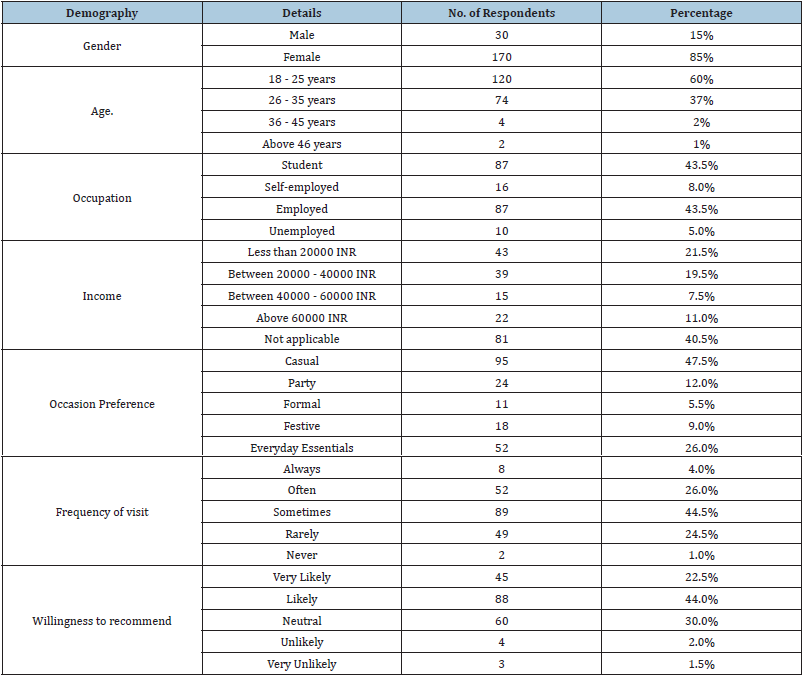
Source: Primary Data.
For occasion preference, 47.5% of respondents prefer Casual, 26% prefer Everyday Essentials, 12% prefer Party, 9% prefer Festive and 5.5% prefer Formal. For frequency of visits 44.5% of respondents visit Sometimes, 26% visits Often, 24.5% visits Rarely, 4% visits Always and 1% visits Never. For willingness to recommend, 44% of respondents are Likely to recommend, 30% are Neutral, 22.5% are Very Likely, 2% are Unlikely and 1.5% are Very Unlikely.
ANOVA with post hoc
To test the significant difference in Repurchase Intention among different demographic profiles including Gender, Age Group, Occupation and Monthly Income, ANOVA test was employed and results of which are in given below.
From Table 2, it is noted that there is a significant difference in Repurchase Intention among customers of different demographic profiles including Gender, Age Group and Occupation (p<0.05) except for monthly income (p>0.05). So, hypothesis 1 is accepted except for income demographics..
Table 2:ANOVA: Demographics vs Repurchase intention.
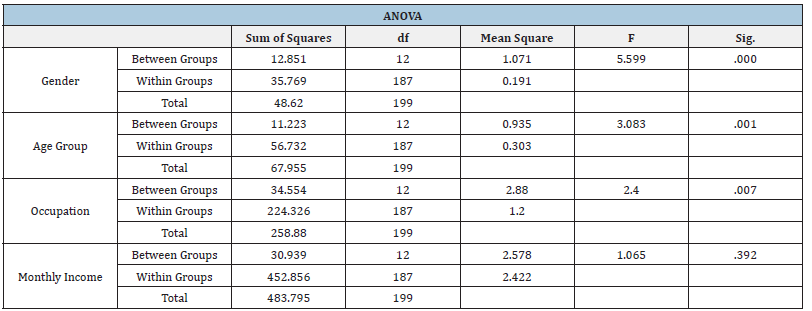
Source: Primary Data.
From Table 3, it can be concluded that there is a statistically significant difference in Repurchase Intention among customers of the age group 18-25 years and 26-35 years (p= .000). However, there are no differences between the other age groups towards Repurchase Intention.
Table 3:Post Hoc Tukey HSD - Age group.
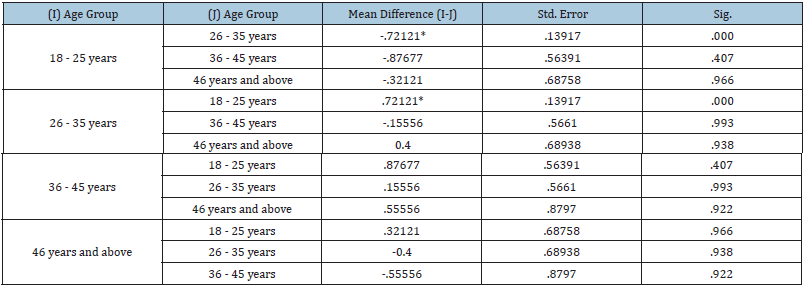
Source:Primary Data.
From Table 4, it can be concluded that there is a statistically significant difference in Repurchase Intention among customers of occupations Student and Employed (p= .001). However, there are no differences between the other occupation towards Repurchase Intention.
Table 4:Post Hoc Tukey HSD - Occupation
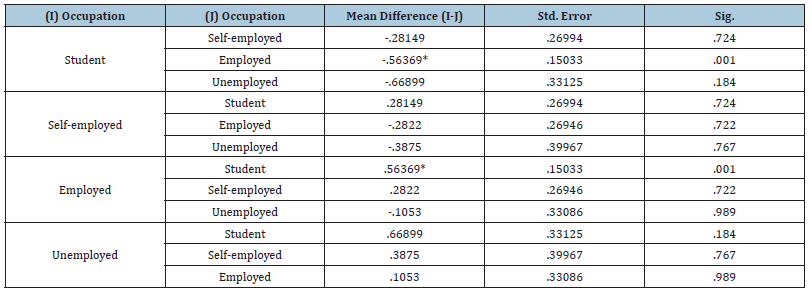
Source:Primary Data.
Cluster analysis
Cluster analysis is conducted for the means of Customer Satisfaction and Repurchase Intention on the basis of the Ward’s method using the Hierarchical cluster analysis. From the analysis three clusters were emerged and the clusters are named Happy Repeater, Moderate and Happy Non-repeater.
Statistical comparison is done using One-way ANOVA to determine if there is any statistical difference between the clusters and the customer satisfaction & repurchase intention.
From Table 5, as a result of the analysis significant differences have been found between the three clusters according to their customer satisfaction. So, hypothesis 2 is accepted i.e., there is a significant difference between the clusters and customer satisfaction.
Table 5:Cluster Vs Customer Satisfaction.
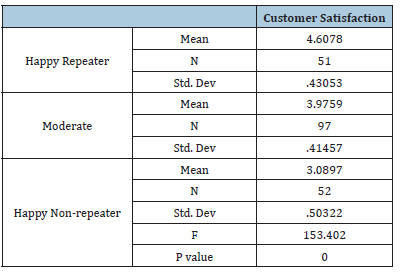
Source:Primary Data.
From Table 6, as a result of the analysis significant differences have been found between the three clusters according to their repurchase intention. So, hypothesis 3 is accepted i.e., there is a significant difference between the clusters and the repurchase intention.
Table 6:Cluster Vs Variables.
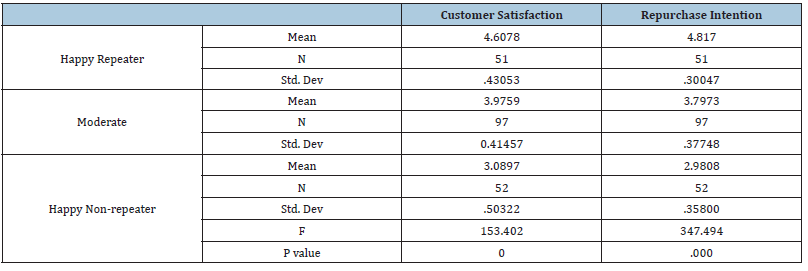
Source:Primary Data.
From the Table 7, in Post Hoc Turkey analysis result shows that their significant differences have found between the three clusters according to their customer satisfaction and repurchase intention. So, hypotheses 3 and 4 are accepted.
Table 7:Post Hoc Tukey HSD - Dependent Variables.
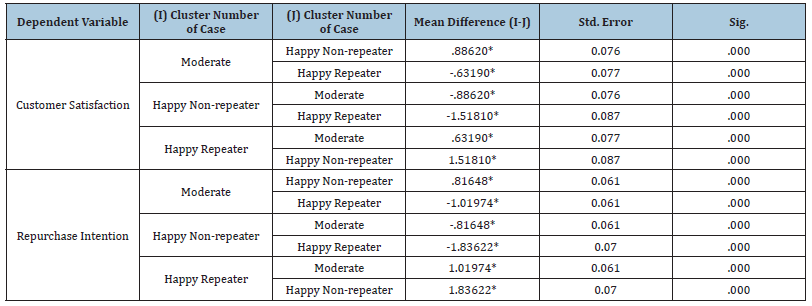
Source:Primary Data.
Demographic and behavioural characteristics of each cluster are shown in Table 7 & Table 8.
Table 8:Post Hoc Tukey HSD - Dependent Variables.
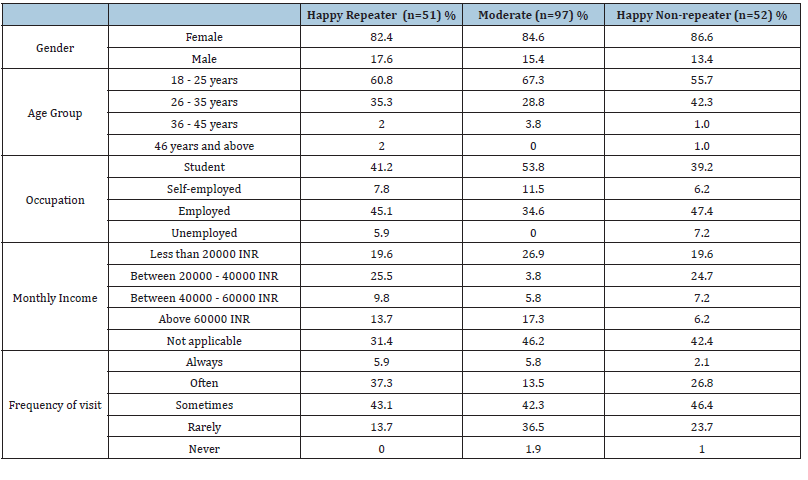
Source:Primary Data.
1. Cluster 1 - Happy Repeater
This group is the most ideal and wanted type of customer. The number of participants is 51 (25.5%) and have the highest level of customer satisfaction (mean=4.6078, std. dev= .43053) and repurchase intention (mean= 4.8170, std. dev= .30047) among three clusters. Employed females of 18-25 years with frequency of visit as sometimes are the main customers of this cluster. They would be satisfied and possibly repeat purchasers for the company.
2. Cluster 2 - Moderates
This group has the majority of participants. The number of participants is 97 (48.5%). The level of customer satisfaction (mean= 3.9759, std. dev= .41457) and repurchase intention (mean= 3.7973, std. dev= .37748) are in above average. These customers can be turned into satisfied and repeat purchasers if they are served properly. The majority of customers in this cluster are female students within the age group of 18-25 years who visits the website/ app sometimes.
3. Cluster 3 - Happy Non-repeater
This group has 52 (26%) of customers. The level of customer satisfaction (mean= 3.0897, std. dev= .50322) and repurchase intention (mean= 2.9808, std. dev= .35800) are low compared to other clusters. They are employed females in an age group of 18 - 25 years who visits the website/ app sometimes. These customers are more likely to switch to competitors easily.
Regression analysis
From Table 9, the regression analysis the F statistics shows that the model is fit (F=135.643, p<0.05) with the 40.7% variance explained and the Beta value is 0.638 (t=11.647; p=0.000) which shows that customer satisfaction has significant positive effect on repurchase intention. So, hypothesis 4 is accepted.
Table 9:Customer satisfaction and Repurchase intention.

Source:Primary Data.
Findings and Discussions
The purpose of the study was to examine customer satisfaction
and repurchase intention on ecommerce clothing brand. The study
results illustrate the following findings:
A. Occasion in which the majority of the respondents
preferred to purchase Casual wear 47.5% of respondents
preferred Casual, 26% preferred Everyday Essentials, 12%
preferred Party, 9% preferred Festive and 5.5% preferred
Formal.
B. Frequency of visit for majority of respondents were
Sometimes. It is noted that 44.5% of respondents visit
Sometimes, 26% visits Often, 24.5% visits Rarely, 4% visits
Always and 1% visits Never.
C. Majority of respondents (44%) are Likely to recommend
e-commerce Fashion website/ app to others, 30% are Neutral,
22.5% are Very Likely, 2% are Unlikely and 1.5% are Very
Unlikely.
D. ANOVA analysis showed that there is a significant
difference in Repurchase Intention among customers of
different demographic profiles including Gender, Age Group and
Occupation (p<0.05), whereas there is no significant difference
in Repurchase Intention for the demographic variable Monthly
Income.
E. Further, Post hoc Tukey HSD is conducted to identify
the age groups having significant difference in Repurchase
Intention and it is found that there is statistically significant
difference in Repurchase Intention among customers of age
group 18 - 25 years and 26 - 35 years (p=.000).
F. Similarly, in the Occupation status, Student and Employed
has a statistically significant difference in Repurchase Intention
(p=.001).
G. From the cluster analysis, based on the demographic
and behavioural segment of customers, three clusters are
formed. Namely Happy Repeater, Moderate and Happy Non
repeater. There are significant differences found between the
three clusters according to their customer satisfaction and
repurchase intention.
H. Cluster 1 (Happy Repeater) is the most ideal customer
with the number of participants 51 (25.5%). This group has the
highest level of customer satisfaction and repurchase intention
among three clusters.
I. Cluster 2 (Moderates) has the majority of participants
with n=97 (48.5%). The level of their customer satisfaction
and repurchase intention are above average. These customers
can be turned into satisfied and repeat purchasers if they are
served properly.
J. Cluster 3 (Happy Non-repeater) has 52 (26%) number of
customers. The level of customer satisfaction and repurchase
intention for this cluster is low compared to other clusters.
These customers are more likely to switch to competitors easily.
K. Customer satisfaction has a significant positive effect on
repurchase intention.
The study shows that there is a significant difference for gender, age group and occupation in repurchase intention. Different clusters are also formed depending on Customer Satisfaction and Repurchase Intention to understand how the company can address each group of customers. It is important for the marketers to formulate different strategies to cater to the specific needs and preferences of each customer group. Understanding differences between these groups and highlighting specific needs or addressing pain points of each group will enable marketers to focus their efforts on the particular target segment and design specific strategies for each.
It is important to make sure that both website and app provide clear and easy navigation with user-friendly interface. As per the study, pricing also has a significant effect on customer satisfaction. Pricing decisions can be made after a thorough analysis of competitors’ pricing strategies. Marketers can optimize their pricing strategies based on these findings and set different price points for each group and customize promotional campaigns to enhance effectiveness. Personalization and recommendations can be improved by using data analytics, machine learning and artificial intelligence. Surveys, reviews etc. can be collected from customers regularly in order to identify areas for improvement and make changes. It is important to provide hassle-free returns so that customers remain satisfied. Other than just providing ratings for the merchandise, reviews along with images or videos can also be included so that customer could get to know a verified opinion from another user which can impart trust and lead to make the purchase decision.
Conclusion
The purpose of the study was to examine customer satisfaction and repurchase intention on online fashion brands. The current study has confirmed the significance of various online variables on customer satisfaction. It is important to focus on improving these factors such as website/ app usability, information availability, price, and quality to improve customer satisfaction. Various other factors also affect customer satisfaction, these has to be identified and improved in future studies in order to improve overall customer satisfaction. It is also found that customer satisfaction has a significant effect on repurchase intention. Based on the findings of the study, it can be concluded that customer satisfaction in online shopping is influenced by several factors. Customers who are satisfied with these factors are more likely to repurchase from the same brand and recommend it to others. Therefore, it is important for online retailers to focus on providing a positive experience to customers by improving these factors to enhance customer satisfaction and loyalty. Customers who perceive high value from the products and services offered by the company, trust the company, and are satisfied with their overall experience are more likely to repurchase from the company. Therefore, it is important for companies to focus on building customer trust, providing high-quality products and services, and delivering exceptional customer service to increase customer satisfaction and repurchase intention. The e-commerce industry is undergoing rapid transformations worldwide. To remain competitive and relevant, online retailers must stay abreast of the latest trends in e-commerce and continuously adapt to meet the ever-changing demands of consumers. The study would provide an insight on various online variables such as website/ app usability, information availability, price, delivery and quality influences on customer satisfaction. This study has few limitations. Future studies may examine broader samples so that accuracy of the data would be improved. Also, respondents from various geographical locations can be compared to understand region wise issues.
References
- Park CH, Kim YG (2003) Identifying key factors affecting consumer purchase behavior in an online shopping context. International Journal of Retail & Distribution Management 31(1): 16-29.
- Karim RA (2013) Customer satisfaction in online shopping: A study into the reasons for motivations and inhibitions. IOSR Journal of Business and Management (IOSR-JBM) 11: 13-20
- Vasić N, Kilibarda M, Kaurin T (2018) The influence of online shopping determinants on customer satisfaction in the Serbian market. Journal of Theoretical and Applied Electronic Commerce Research 14(2): 70-89.
- Hsu SH (2008) Developing an index for online customer satisfaction: Adaptation of American customer satisfaction index. Expert Systems with Applications 34(4): 3033-3042.
- Alam SS, Ali MH, Omar NA, Hussain WM (2020) Customer satisfaction in online shopping in growing markets: An empirical study. International Journal of Asian Business and Information Management 11(1): 78-91.
- Nguyen L, Nguyen TH, Tan TK (2021) An empirical study of customers’ satisfaction and repurchase intention on online shopping in Vietnam. Journal of Asian Finance, Economics and Business 8(1): 971-983.
- Yo PW, Kee DM, Yu JW, Hu MK, Jong YC, et al. (2021) The influencing factors of customer satisfaction: A case study of shopee in Malaysia. Studies of Applied Economics 39(12).
- Abdeldayem MM (2010) A study of customer satisfaction with online shopping: Evidence from the UAE. Int J Advanced Media and Communication 4(3): 235-257.
- Lee K, Joshi K (2006) Development of an integrated model of customer satisfaction with online shopping. SIGMIS-CPR’06, Claremont, California, USA, pp. 53-56.
- Lin GT, Sun CC (2009) Factors influencing satisfaction and loyalty in online shopping: An integrated model. Online Information Review 33(3): 458-475.
- Wang M, Huarng AS (2002) An empirical study of internet store customer post-shopping satisfaction. IACIS, pp.632-638.
- Cattapan T, Pongsakornrungsilp S (2022) Impact of omnichannel integration on Millennials' purchase intention for fashion retailer. Cogent Business & Management 9(1): 1-26.
- Tzeng SY, Ertz M, Jo MS, Sarigollu E (2020) Factors affecting customer satisfaction on online shopping holiday. Marketing Intelligence & Planning 39(4): 516-532.
- Ziaullah M, Feng Y, Akhter SN (2014) E-Loyalty: The influence of product quality and delivery services on e-trust and e-satisfaction in China. International Journal of Advancements in Research & Technology 3(10): 20-31.
- Hellier PK, Geursen GM, Carr RA, Rickard JA (2003) Customer repurchase intention: A general structural equation model. European Journal of Marketing 37(11): 1762-1800.
- Khoa BT, Nguyen TD, Nguyen VTT (2020) Factors affecting customer relationship and the repurchase intention of designed fashion products. Journal of Distribution Science 18(2): 17-28.
- Suleman D, sabil S, Rusiyati S, Sari I, Rachmawati S, et al. (2021) Exploring the relationship between trust, ease of use after purchase and switching re-purchase intention. International Journal of Data and Network Science 5(3): 465-470.
- Chatzoglou P, Chatzoudes D, Savvidou A, Fotiadis T, Delias P (2022) Factors affecting repurchase intentions in retail shopping: An empirical study. Heliyon 8(9): e10619.
- Miao M, Jalees T, Imran Zaman S, Khan S, Javed MK (2021) The influence of e-customer satisfaction, e-trust and perceived value on consumer's repurchase intention in B2C e-commerce segment. Asia Pacific Journal of Marketing and Logistics 34(10): 2184-2206.
- Al-Jahwari NS, Khan MF, Kalbani GK, Khansouri SS (2018) Factors influencing customer satisfaction of online shopping in Oman - youth perspective. Humanities & Social Science Reviews 6(2): 64-73.
- Tandon U, Kiran R, Sah AN (2017) Customer satisfaction as mediator between website service quality and repurchase intention: An emerging economy case. Service Science 9(2): 106-120.
- Alreck PL, DiBartolo GR, Diriker M, Dover HF, Passyn KA, et al. (2009) Time pressure, time saving and online shopping: Exploring a contradiction. The Journal of Applied Business Research 25(5): 85-92.
© 2024 M Krishnakumar. This is an open access article distributed under the terms of the Creative Commons Attribution License , which permits unrestricted use, distribution, and build upon your work non-commercially.
 a Creative Commons Attribution 4.0 International License. Based on a work at www.crimsonpublishers.com.
Best viewed in
a Creative Commons Attribution 4.0 International License. Based on a work at www.crimsonpublishers.com.
Best viewed in 







.jpg)






























 Editorial Board Registrations
Editorial Board Registrations Submit your Article
Submit your Article Refer a Friend
Refer a Friend Advertise With Us
Advertise With Us
.jpg)






.jpg)














.bmp)
.jpg)
.png)
.jpg)










.jpg)






.png)

.png)



.png)






